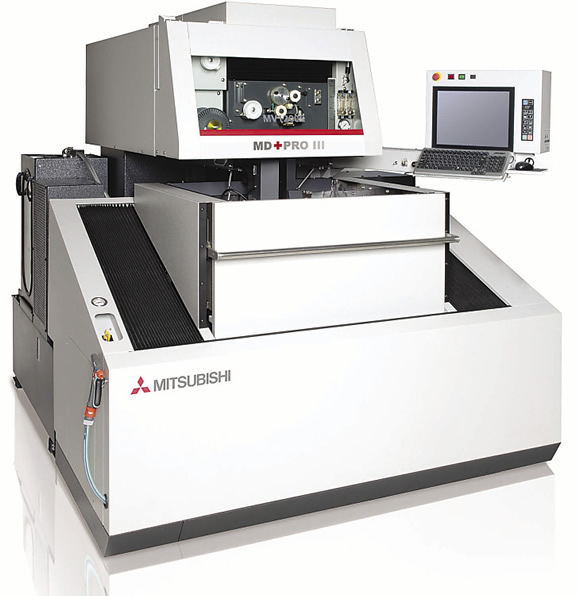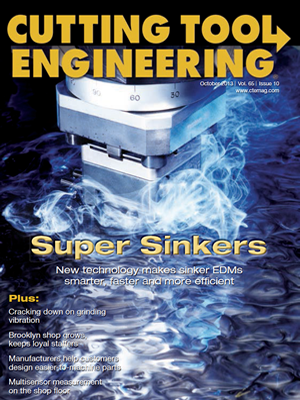END USER: Smartech Corp., (914) 668-6801, www.smartechcnc.com.
CHALLENGE: Cutting cycle time for a 3,000-piece run.
SOLUTION: Two wire EDMs.
SOLUTION PROVIDER: MC Machinery Systems Inc., (630) 616-5920, www.mitsubishi-world.com.
Smartech Corp., Mount Vernon, N.Y., expanded its capabilities by adding two new wire EDMs: a Mitsubishi MD+ Pro III Advance and an MD+ Pro II Advance. The machines are from MC Machinery Systems Inc., Wood Dale, Ill.
“These machines were instrumental in allowing me to meet the demands of one 3,000-piece job, cutting the run time for each part by more than 40 percent vs. milling the part,” said Michel Chahade, Smartech’s owner. He noted the part has a complex taper shape with thin walls, and milling it required Smartech to create four fixtures for it and perform several setups and operations. “The more operations, the more room for error.”
The $1 million, 3-year-plus contract from the military was for a component of the M240 machine gun bipod. The part is approximately 3 "×2 "×1.5 " (76.2mm × 50.8mm × 38.1mm).

The Mitsubishi MD+ Pro III Advance features an automatic threading system that can anneal a 14 "-long wire.
In addition to military parts, Smartech specializes in medical, motor sport, power generation, aerospace and automotive parts. The seven-person job shop has eight machine tools. It can handle workpieces up to 40 "×20 " (140.6cm × 50.8cm) and 4-axis rotary work up to 12 " (30.5cm) in diameter.
Now that the initial job is finished, Smartech is running a similar job on the wire EDMs. Having the wire EDMs frees up time on the milling machines for other jobs.
The MD+ Pro III Advance features the new M700 series control with 15 " touch screen. The noncontact cylindrical drive system on the X- and Y-axis drives uses linear shaft motors with a servosystem that utilizes fiber optic communication. The linear shaft motors use high-power permanent magnets in a tube with the electronic coils in the forcer, which surrounds the tube using 360° of magnetic flux. The magnet tube and forcer replace the typical ballscrew and nut to provide backlash-free drive, according Greg Langenhorst, technical marketing manager at MC Machinery Systems.
The MD+ Pro III also features improvements in machine construction, internal machine communication and power supply technology. “The V350-V power supply, combined with the fiber optic communication system, senses each individual spark and shapes it to optimize the material removal, increasing cutting speed while causing less damage to the wire,” Langenhorst said. “This reduced wire wear has allowed a reduction in wire speed across the board, with wire consumption savings up to as much as 60 percent over our older FA Model EDMs.”
Chahade noted he finds the automatic threading function extremely accurate. “Compared to the other wire EDMs I have worked with, the MD+ Pro III has a much more reliable threading system. It doesn’t get stuck when threading between long distances [on thick parts].”
The new auto-threading system has moved the annealing contact points so it can now anneal a 14 "-long wire, which removes 90 percent of the curl from the wire spool, according to Langenhorst. “That, combined with the operator-selectable auto-threading modes, increases the reliability of threading very tall workpieces and rethreading through the gap if a wire break should occur.”
Smartech’s other wire EDM, the MD+ Pro II, is the smallest and most economical Mitsubishi wire EDM. Its stacked-filter design reduces floor space requirements.
With these new Mitsubishi wire EDMs, Smartech can take on more demanding projects. Chahade noted another benefit of the EDMs is they can run overnight unattended.
Related Glossary Terms
- annealing
annealing
Softening a metal by heating it to and holding it at a controlled temperature, then cooling it at a controlled rate. Also performed to produce simultaneously desired changes in other properties or in the microstructure. The purposes of such changes include improvement of machinability, facilitation of cold work, improvement of mechanical or electrical properties and increase in stability of dimensions. Types of annealing include blue, black, box, bright, full, intermediate, isothermal, quench and recrystallization.
- cutting speed
cutting speed
Tangential velocity on the surface of the tool or workpiece at the cutting interface. The formula for cutting speed (sfm) is tool diameter 5 0.26 5 spindle speed (rpm). The formula for feed per tooth (fpt) is table feed (ipm)/number of flutes/spindle speed (rpm). The formula for spindle speed (rpm) is cutting speed (sfm) 5 3.82/tool diameter. The formula for table feed (ipm) is feed per tooth (ftp) 5 number of tool flutes 5 spindle speed (rpm).
- electrical-discharge machining ( EDM)
electrical-discharge machining ( EDM)
Process that vaporizes conductive materials by controlled application of pulsed electrical current that flows between a workpiece and electrode (tool) in a dielectric fluid. Permits machining shapes to tight accuracies without the internal stresses conventional machining often generates. Useful in diemaking.
- gang cutting ( milling)
gang cutting ( milling)
Machining with several cutters mounted on a single arbor, generally for simultaneous cutting.
- milling
milling
Machining operation in which metal or other material is removed by applying power to a rotating cutter. In vertical milling, the cutting tool is mounted vertically on the spindle. In horizontal milling, the cutting tool is mounted horizontally, either directly on the spindle or on an arbor. Horizontal milling is further broken down into conventional milling, where the cutter rotates opposite the direction of feed, or “up” into the workpiece; and climb milling, where the cutter rotates in the direction of feed, or “down” into the workpiece. Milling operations include plane or surface milling, endmilling, facemilling, angle milling, form milling and profiling.
- threading
threading
Process of both external (e.g., thread milling) and internal (e.g., tapping, thread milling) cutting, turning and rolling of threads into particular material. Standardized specifications are available to determine the desired results of the threading process. Numerous thread-series designations are written for specific applications. Threading often is performed on a lathe. Specifications such as thread height are critical in determining the strength of the threads. The material used is taken into consideration in determining the expected results of any particular application for that threaded piece. In external threading, a calculated depth is required as well as a particular angle to the cut. To perform internal threading, the exact diameter to bore the hole is critical before threading. The threads are distinguished from one another by the amount of tolerance and/or allowance that is specified. See turning.
- wire EDM
wire EDM
Process similar to ram electrical-discharge machining except a small-diameter copper or brass wire is used as a traveling electrode. Usually used in conjunction with a CNC and only works when a part is to be cut completely through. A common analogy is wire electrical-discharge machining is like an ultraprecise, electrical, contour-sawing operation.


